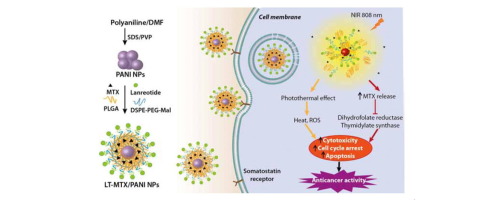Acta Biomaterialia ( IF 9.4 ) Pub Date : 2017-12-30 , DOI: 10.1016/j.actbio.2017.12.033 Hanh Thuy Nguyen , Cao Dai Phung , Raj Kumar Thapa , Tung Thanh Pham , Tuan Hiep Tran , Jee-Heon Jeong , Sae Kwang Ku , Han-Gon Choi , Chul Soon Yong , Jong Oh Kim

|
Lanreotide (LT), a synthetic analog of somatostatin, has been demonstrated to specifically bind to somatostatin receptors (SSTRs), which are widely overexpressed in several types of cancer cells. In this study, we incorporated a chemotherapeutic agent, methotrexate (MTX), and a photosensitizer material, polyaniline (PANI), into hybrid polymer nanoparticles (NPs), which could target cancer cells after conjugation with LT (LT-MTX/PANI NPs). The successful preparation of LT–MTX/PANI NPs was confirmed by a small particle size (187.9 ± 3.2 nm), a polydispersity index of 0.232 ± 0.011, and a negative ς potential of -14.6 ± 1.0 mV. Notably, LT-MTX/PANI NPs showed a greater uptake into SSTR-positive cancer cells and thereby better inhibited cell viability and induced higher levels of apoptosis than MTX, PANI NP, and MTX/PANI NP treatments did. In addition, the heat associated with the burst drug release induced by near-infrared (NIR) irradiation resulted in remarkably enhanced cell apoptosis, which was confirmed by an increase in the expression levels of apoptotic marker proteins. In agreement with the in vitro results, the administration of the SSTR-targeting NPs, followed by NIR exposure, to xenograft tumor-bearing mice resulted in an improved suppression of tumor development compared to that shown by MTX, PANI NPs, and MTX/PANI NPs, as well as by LT-MTX/PANI NPs without photothermal therapy. Thus, the SSTR-targeting NPs could be a promising delivery system for the effective treatment of SSTR-positive cancers.
Statement of significance
Somatostatin receptors are widely overexpressed in several types of cancer cells. In this study, we designed nanoparticles for targeted delivery of chemotherapeutic agents to tumor sites by conjugating hybrid polymers with a synthetic analog of somatostatin, specifically binding to somatostatin receptors. In addition, a photosensitizer material, polyaniline, was incorporated into the nanoparticles for combined chemo–photothermal therapy. The results demonstrated clear advantages of the newly designed targeted nanoparticles over their non-targeted counterparts or a free chemotherapeutic drug in inhibiting the viability of cancer cells in vitro and targeting/suppressing the tumor growth in an animal xenograft model. The study suggests that the designed nanoparticles are a promising delivery system for the effective treatment of somatostatin receptor-positive cancers.
中文翻译:

多功能纳米颗粒作为聚苯胺和甲氨蝶呤的生长抑素受体靶向递送系统,用于化学-光热疗法的联合治疗
兰瑞肽(LT)是生长抑素的合成类似物,已被证明与生长抑素受体(SSTR)特异性结合,而生长抑素受体在几种类型的癌细胞中广泛表达。在这项研究中,我们将化学治疗剂甲氨蝶呤(MTX)和光敏剂材料聚苯胺(PANI)掺入了杂化聚合物纳米粒子(NPs)中,该纳米粒子可与LT(LT-MTX / PANI NPs)结合后靶向癌细胞。LT-MTX / PANI NPs的成功制备得到证实,其粒径小(187.9±3.2 nm),多分散指数为0.232±0.011,负电势为-14.6±1.0 mV。值得注意的是,与MTX,PANI NP和MTX / PANI NP处理相比,LT-MTX / PANI NPs对SSTR阳性癌细胞的摄取更大,从而更好地抑制了细胞活力并诱导了更高水平的凋亡。此外,近红外(NIR)辐射诱导的与药物释放爆发有关的热量导致细胞凋亡显着增强,这可通过凋亡标记蛋白表达水平的提高得到证实。同意在体外结果中,与MTX,PANI NP和MTX / PANI NP相比,向异种移植荷瘤小鼠施用靶向SSTR的NP,然后进行NIR暴露,可改善对肿瘤的抑制作用如未经光热疗法的LT-MTX / PANI NP。因此,靶向SSTR的NPs可能是有效治疗SSTR阳性癌症的有希望的递送系统。
重要声明
生长抑素受体在几种类型的癌细胞中广泛过量表达。在这项研究中,我们设计了纳米颗粒,通过将杂化聚合物与生长抑素的合成类似物缀合(特异性结合生长抑素受体),将化学治疗剂靶向递送至肿瘤部位。另外,将光敏剂材料聚苯胺掺入纳米颗粒中,以进行化学-光热疗法联合治疗。结果表明,新设计的靶向纳米粒子在抑制癌细胞体外存活力方面比其非靶向对应物或游离化学治疗药物具有明显优势。并靶向/抑制动物异种移植模型中的肿瘤生长。研究表明,设计的纳米颗粒是有效治疗生长抑素受体阳性癌症的有前途的递送系统。











































 京公网安备 11010802027423号
京公网安备 11010802027423号